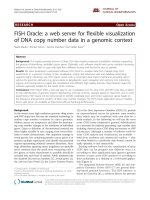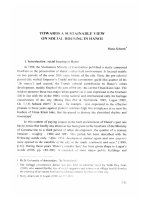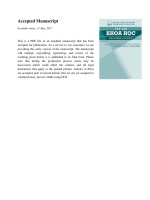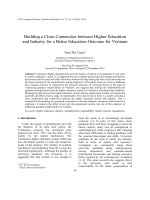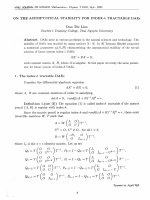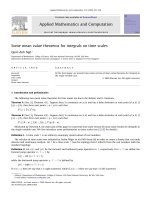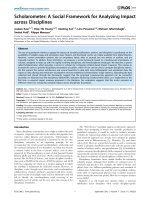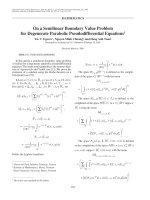DSpace at VNU: ReplacementMatrix: a web server for maximum-likelihood estimation of amino acid replacement rate matrices
Bạn đang xem bản rút gọn của tài liệu. Xem và tải ngay bản đầy đủ của tài liệu tại đây (84.49 KB, 3 trang )
BIOINFORMATICS APPLICATIONS NOTE
Phylogenetics
Vol. 27 no. 19 2011, pages 2758–2760
doi:10.1093/bioinformatics/btr435
Advance Access publication July 26, 2011
ReplacementMatrix: a web server for maximum-likelihood
estimation of amino acid replacement rate matrices
Cuong Cao Dang1 , Vincent Lefort2 , Vinh Sy Le1 , Quang Si Le3 and Olivier Gascuel2,∗
1 College of
2 Méthodes
Technology and Information Technology Institute, Vietnam National University, Hanoi, Vietnam,
et algorithmes pour la Bioinformatique, LIRMM, CNRS – Université Montpellier 2, Montpellier, France and
3 Wellcome Trust Sanger Institute, Genome Campus, Hinxton, Cambridge CB10 1SA, UK
Associate Editor: David Posada
Received on March 1, 2011; revised on June 29, 2011; accepted on
July 19, 2011
1
INTRODUCTION
Amino acid replacement matrices contain estimates of the
instantaneous substitution rates from any amino acid to another.
These rates reflect the biological, chemical and physical properties
of amino acids. For example, we usually observe a high substitution
rate between lysine (positively charged) and arginine (also positively
charged) and a low substitution rate between lysine and aspartate
(negatively charged). Amino acid replacement matrices are an
essential basis of protein phylogenetics. They are used to compute
substitution probabilities along phylogeny branches, and thus the
likelihood of the data. They are also closely related to score matrices,
which are essential for aligning proteins and computing alignment
scores.
∗ To
whom correspondence should be addressed.
2758
Several general replacement matrices have been proposed, such as
PAM (Dayhoff et al., 1978), JTT (Jones et al., 1992), WAG (Whelan
and Goldman, 2001) and LG (Le and Gascuel, 2008). These matrices
were estimated from large and diverse sets of protein alignments.
They tend to be robust and perform well in many cases. However,
the performance of replacement matrices depends on life domains
and protein groups (Keane et al., 2006). Replacement matrices have
thus been estimated for specific domains [e.g. for HIV, Nickle et al.,
(2007), and influenza, Dang et al. (2010)] and protein groups [e.g.
mitochondrial proteins, Adachi and Hasegawa (1996)]. It has been
shown that specific replacement matrices often differ significantly
from general matrices, and thus perform better when applied to the
data to which they are dedicated [e.g. Adachi and Hasegawa (1996);
Dang et al. (2010)].
Since the seminal work of Dayhoff et al. (1978), a number of
methods have been designed to estimate amino acid replacement
matrices from protein alignments. These methods belong to
either counting (e.g. Jones et al., 1992) or maximum-likelihood
(ML) approaches (e.g. Adachi and Hasegawa, 1996, Yang et al.,
1998, Whelan and Goldman, 2001). The former are limited to
pairwise protein alignments, while the latter fully benefit from the
information contained in multiple alignments and the corresponding
phylogenies. Recently, we improved the ML method proposed by
Whelan and Goldman (2001) by incorporating the variability of
evolutionary rates across sites into the matrix estimation process
(Le and Gascuel, 2008). This procedure was successfully applied to
estimate the LG matrix from 3912 alignments of the Pfam database,
the FLU matrix from 992 influenza protein alignments and a number
of matrices corresponding to various structural configurations of the
residues (Le and Gascuel, 2010).
The demand to estimate amino acid replacement matrices for
particular data is rising quickly because of the rapidly growing
volume of sequence data and a desire to better understand the
evolution and relationships of specific protein groups and species.
However, up-to-date replacement matrix estimation procedures are
complex and highly demanding in computational terms. Our method
(Le and Gascuel, 2008) involves complex data processing and
alternates tree building using PhyML (Guindon et al., 2010) and
matrix estimation using XRATE (Klosterman et al., 2006). It thus
requires a huge amount of work to estimate a matrix from raw
datasets. Here, we describe an implementation of this method
in a Web server. Users upload their alignments and receive the
output matrix by email along with a number of additional statistics
and comparisons. Optionally, the server performs a non-parametric
Downloaded from at UCSF Library on May 9, 2014
ABSTRACT
Summary: Amino acid replacement rate matrices are an essential
basis of protein studies (e.g. in phylogenetics and alignment).
A number of general purpose matrices have been proposed (e.g.
JTT, WAG, LG) since the seminal work of Margaret Dayhoff and coworkers. However, it has been shown that matrices specific to certain
protein groups (e.g. mitochondrial) or life domains (e.g. viruses) differ
significantly from general average matrices, and thus perform better
when applied to the data to which they are dedicated. This Web
server implements the maximum-likelihood estimation procedure
that was used to estimate LG, and provides a number of tools and
facilities. Users upload a set of multiple protein alignments from
their domain of interest and receive the resulting matrix by email,
along with statistics and comparisons with other matrices. A nonparametric bootstrap is performed optionally to assess the variability
of replacement rate estimates. Maximum-likelihood trees, inferred
using the estimated rate matrix, are also computed optionally for
each input alignment. Finely tuned procedures and up-to-date ML
software (PhyML 3.0, XRATE) are combined to perform all these
heavy calculations on our clusters.
Availability: />Contact:
Supplementary information: Supplementary data are available at
/>
© The Author 2011. Published by Oxford University Press. All rights reserved. For Permissions, please email:
[15:05 5/9/2011 Bioinformatics-btr435.tex]
Page: 2758
2758–2760
ReplacementMatrix
bootstrap to assess the variability of rate estimations, and infers the
phylogeny of every input alignment using the estimated replacement
matrix.
Step 2: (a) For each alignment, infer an ML tree using PhyML 3.0 with Q1 ,
4 and the SPR tree search option.
(b) Same as (1b).
(c) Same as (1c), but replace S by Q1 and output Q2 .
2
MODEL AND METHODS
Step 0: input a set of multiple alignments and a starting replacement matrix
S; only exchangeabilities in S are used, frequencies are estimated
from the data.
Step 1: (a) For each alignment, build a BioNJ tree and optimize the branch
lengths and gamma rate parameter using PhyML with S and 4.
(b) Process the alignments and trees to account for the 4
model: every alignment is divided into four subalignments using
the posterior probability of site rate categories, and the four
corresponding trees are rescaled using the rates estimated for each
category under the gamma model.
(c) Run XRATE with default options and S starting matrix to estimate
a first matrix Q1 from the processed alignments and trees.
(b) Same as (1b).
(c) Same as (1c), but replace S by Q2 and output final Q matrix.
Step 4: For each alignment, re-optimize the branch lengths of the previously
inferred ML tree and the gamma rate parameter using PhyML with
Q, with S, and with LG when S = LG; output the corresponding
log likelihood and AIC values of every alignment and site for
comparison purposes.
Only Step (2) in this procedure fully constructs an ML tree; Step (1) uses
a distance-based tree topology (as with WAG estimation), while Step (3)
reuses the ML topology inferred during Step (2) with a fairly accurate Q1
matrix. Other parts are the same as in the original LG estimation procedure
(except for the invariant site category, removed here).
When the final matrix has been estimated, it is returned along with a
number of results, statistics and comparisons. Two additional options are
available: (i) performing a bootstrap study to assess the variability of rate
estimates; and (ii) running PhyML 3.0 with Q and standard options to infer the
phylogenies estimated with the new matrix for all input alignments. When the
latter option is used, the pipeline simultaneously estimates the replacement
matrix and the trees from the input alignments. These are expected to be
significantly different from the phylogenies inferred with starting matrix S
or LG. To save computing time, the starting trees and initial parameter values
are taken from Step (4) in the above procedure.
The aim of the bootstrap procedure is to measure the variability of
rate estimations. This should be useful, for example, when comparing the
properties of amino acids in specific contexts (Kosiol et al., 2004), or when
using replacement rate matrices in the search for non-standard genetic codes
(Abascal et al., 2007). The bootstrap is performed in a standard manner:
for every alignment Da in D, we draw with replacement |Da | sites and
then run the estimation procedure to obtain a pseudo rate matrix; this is
repeated several times and the pseudo matrices are used to compute several
statistics (e.g. the standard deviation) for each of the frequency πi and
exchangeability rij parameters. This procedure is highly time consuming,
and we thus only perform 10 replicates. Moreover, the estimation scheme
described above is still too heavy to be repeated 10 times. We therefore use
the trees and site rate categories computed by PhyML with Q in Step (4),
and run XRATE only once for each replicate, starting from the S matrix.
Experimental studies show that these simplifications do not significantly
affect the variability measures.
3
Downloaded from at UCSF Library on May 9, 2014
The amino acid substitution process is assumed to be independent among
sites and lineages, and homogeneous during the course of evolution.
The standard model is Markovian, time-continuous, time-reversible and
represented by a 20×20 rate matrix Q = qij , where qij (i = j) is the number
of substitutions from amino acid i to amino acid j per time unit. The diagonal
elements qii are such that the row sums are all zero. Any time-reversible
matrix Q can be decomposed into a symmetric exchangeability matrix
R = rij and an amino acid equilibrium frequency vector = πi , using
equality qij = rij πj (i = j). Moreover, Q is normalized, that is − πi qii = 1.
Here, we consider (as usual) the most general time-reversible (GTR) model,
which involves 189 (R) and 19 ( ) free parameters to be estimated from the
data [see textbooks for additional explanation, e.g. Felsenstein (2003)].
Given a set of protein alignments D = {Da }, Q is estimated by maximizing
the likelihood L D = L Ta ,ρa ,Q;Da , where the product runs over
all alignments Da and the inner term is the likelihood of Da given the
phylogenetic tree Ta , the rate across site model ρa and the replacement
matrix Q. Here we use the standard discrete gamma distribution with four
rate categories, and ρa is the gamma parameter associated with Da .
Simultaneously optimizing T , Q and ρ parameters is computationally
difficult. However, several authors have showed that substitution model
parameters (Q and ρ) can be accurately estimated using nearly optimal trees
T . Whelan and Goldman (2001) estimated their WAG matrix by: (i) inferring
tree topologies using NJ; (ii) estimating tree branch lengths by ML assuming
a JTT replacement process; and (iii) estimating Q from the data and thereby
inferred trees using a standard optimization procedure.
We refined this approach by incorporating an across-site rate model in
the matrix estimation, namely four gamma categories plus invariant sites
( 4+I). Our method (Le and Gascuel, 2008) involves: (i) estimating tree
topologies and branch lengths using PhyML (Guindon et al., 2010); (ii)
processing alignment and trees to account for the rate model; (iii) estimating
Q from these processed data and trees using the expectation–maximization
software XRATE (Klosterman et al., 2006); and (iv) iterating this procedure
until L D reaches a plateau. This estimation procedure is started using an
approximate matrix. WAG was used to learn LG, and a nearly identical matrix
was obtained when starting from JTT. We observed that three iterations are
enough in practice and that the invariant site category has little impact on Q
estimation.
The above procedure is very heavy in computational terms. It is simplified
here. The most time-consuming aspect is the ML estimation of tree
topologies, which is performed only once here (instead of ∼3 times in the
original procedure). Moreover, the rate model is simplified by using four
gamma rate categories, but no invariant sites ( 4). The resulting matrix is
nearly the same as that obtained using the full procedure (see results below)
but the run time is 2–3 times faster. The simplified procedure has three main
estimation steps (1, 2 and 3) and is as follows:
Step 3: (a) For each alignment, re-optimize the branch lengths of the
previously inferred ML tree and gamma rate parameter using PhyML
with Q2 and 4.
RESULTS WITH TWO SAMPLE DATASETS
To illustrate the properties of the Web server, we re-estimated
the LG matrix from the data used in original publication (3912
alignments, ∼6.5 millions residues) and the FLU matrix using
100 randomly selected alignments from the original dataset (∼1.8
million residues). We performed a bootstrap with 500 (LG) and 1000
(FLU100) replicates to obtain accurate measures of the variability
of parameter estimates, and 20 standard pipeline bootstrap runs with
10 replicates each. Detailed results are available as Supplementary
Material from the Web site and summarized in Table 1.
We see that the new LG matrix estimated by the Web
server is nearly identical to the published matrix, despite the
simplifications in the estimation procedure. The new FLU100
matrix (estimated from 100 alignments) is also very close to
2759
[15:05 5/9/2011 Bioinformatics-btr435.tex]
Page: 2759
2758–2760
C.C.Dang et al.
Table 1. Results with LG and FLU100 datasets
LG
FLU100
R2
σi /πi
σij /rij
R2 σi /πi
R2 σij /rij
0.996
0.987
0.004
0.029
0.044
0.185
0.81 ± 0.07
0.89 ± 0.03
0.94 ± 0.01
0.88 ± 0.04
R2 : Pearson’s correlation of the matrix estimated by the Web server and the published
matrix. σi /πi (σij /rij ): average relative deviation of the frequencies (exchangeabilities)
obtained with 500 (LG) and 1000 (Flu100) bootstrap replicates. R2 σi /πi (R2 σij /rij ):
average and SD (among 20 trials) of the Pearson’s correlations of the relative deviations
of frequencies (exchangeabilities) computed with 10 replicates, and those computed
with 500 (LG) and 1000 (FLU100) replicates.
When the bootstrap and/or PhyML options are selected, the user
receives separate emails providing:
• The SD, relative deviation, minimum and maximum values
(among 10 bootstrap estimates) for each of the frequency and
exchangeability parameters.
• All trees inferred by PhyML 3.0 using the new matrix with SPR
and standard options for each of the input alignments.
The current waiting time when all options are selected is ∼10 days
for the very large LG dataset, and ∼2 days with FLU100.
ACKNOWLEDGEMENTS
We thank Ian Holmes and Christophe Dessimoz for their help
Funding: Vietnam National Foundation for Science and
Technology Development; French ANR,MITO-SYS project
(BIOSYS06_136906).
Conflict of Interest: none declared.
REFERENCES
4
WEB SERVER, INPUT AND OUTPUT FILES
The main input is a set of multiple alignments in PHYLIP or
Fasta format. This typically contains hundreds or even thousands of
alignments. However, each alignment must contain <100 sequences
to reduce the computational burden. Larger alignments must be
divided into several subalignments that are given separately. A
starting replacement matrix may also be provided, otherwise LG
is the default. Two options allow for bootstrapping and running
PhyML with the estimated matrix. The user receives a job status
URL and the estimated matrix by email along with a number of files
and statistics. These include (see user guide for details):
• The new rate matrix in PAML triangular format, where
exchangeability rij and frequency πi parameters are given
separately. These parameter values are compared with those of
the starting matrix S and of LG (when S = LG), using Pearson’s
correlation, histograms and bubble graphs.
• A series of score matrices for various evolutionary distances
(δ), derived from the rate matrix using standard log odds:
log πi Pr i → j|δ /πi πj , where the probability of change from
i to j given δ is calculated by exponentiation of the rate matrix
(Felsenstein, 2003). As with PAM matrices, the δ distance
ranges from 0.10 (corresponding to PAM10) to 2.5 (PAM250).
These matrices can be used, for example, with MAFFT,
CLUSTALW or BLAST to search for homologs or compute
multiple alignments of specific protein groups.
Abascal,F. et al. (2007) MtArt: a new model of amino acid replacement for Arthropoda.
Mol. Biol. Evol., 24, 1–5.
Adachi,J. and Hasegawa,M. (1996) Model of amino acid substitution in proteins
encoded by mitochondrial DNA. J. Mol. Evol., 42, 459–468.
Dang,C. et al. (2010) FLU, an amino acid substitution model for influenza proteins.
BMC Evol. Biol., 10, 99.
Dayhoff,M.O. et al. (1978) A model of evolutionary change in proteins. In Dayhoff,M.O.
(ed.) Atlas of Protein Sequence and Structure. National Biomedical Research
Foundation, Washington, DC, pp. 345–352.
Felsenstein,J. (2003) Inferring Phylogenies. Sinauer, Sunderland, MA.
Guindon,S. et al. (2010) New algorithms and methods to estimate maximum-likelihood
phylogenies: assessing the performance of PhyML 3.0. Syst. Biol., 59, 307–321.
Jones,D.T. et al. (1992) The rapid generation of mutation data matrices from protein
sequences. Bioinformatics, 8, 275–282.
Keane,T.M. et al. (2006) Assessment of methods for amino acid matrix selection and
their use on empirical data shows that ad hoc assumptions for choice of matrix are
not justified. BMC Evol. Biol., 6, 29.
Klosterman,P.S. et al. (2006) XRate: a fast prototyping, training and annotation tool for
phylo-grammars. BMC Bioinformatics, 7, 428.
Kosiol,C. et al. (2004) A new criterion and method for amino-acid classification.
J. Theor. Biol., 7, 97–106.
Le,S.Q. and Gascuel,O. (2008) An improved general amino acid replacement matrix.
Mol. Biol. Evol., 25, 1307–1320.
Le,S.Q. and Gascuel,O. (2010) Accounting for solvent accessibility and secondary
structure in protein phylogenetics is clearly beneficial. Syst. Biol., 59, 277–287.
Nickle,D.C. et al. (2007) HIV-specific probabilistic models of protein evolution. PLoS
one, 2, e503.
Whelan,S. and Goldman,N. (2001) A general empirical model of protein evolution
derived from multiple protein families using a maximum-likelihood approach. Mol.
Biol. Evol., 18, 691–699.
Yang,Z. et al. (1998). Models of amino acid substitution and applications to
Mitochondrial protein evolution. Mol. Biol. Evol., 15, 1600–1611.
Downloaded from at UCSF Library on May 9, 2014
the original one (estimated from 992 alignments). The relative
deviations of equilibrium frequencies (σi /πi ) are quite low, while
those of exchangeabilities (σij /rij ) are higher, especially with
FLU100 where their average is nearly equal to 20%. This finding
shows that exchangeabilities are much more difficult to estimate
than frequencies. Exchangeabilities measure instantaneous rates
of change, which are not directly observable from the data (as
frequencies are) and may correspond to hidden changes between
ancestral states. With highly conserved alignments as FLU100’s,
some amino acid pairs are rarely seen together in the same
alignment site (e.g. Cys-Lys is present four times only among
∼37 000 sites, see Supplementary Material), and thus estimating
their exchangeabilities is inevitably a difficult task. Finally, we
see that the bootstrap variability measures with 10 replicates are
clearly correlated with those obtained using a large number of
replicates (500 and 1000), and should thus be useful for analyzing
the differences between rates or between matrices.
• The fit of the new rate matrix to the input data is compared with
that of S and of LG (when S = LG), using the log-likelihood
difference on the whole dataset, divided by the total number of
sites. To account for the fact that the new matrix is estimated
from these data and thus has to be penalized for its (189 + 19)
additional parameters, we use the AIC difference divided by
the number of sites. The AIC and log-likelihood differences are
also provided for every alignment and every site, for example
to detect atypical alignments or site classes. Z-tests are used to
assess the significance of AIC differences.
2760
[15:05 5/9/2011 Bioinformatics-btr435.tex]
Page: 2760
2758–2760
